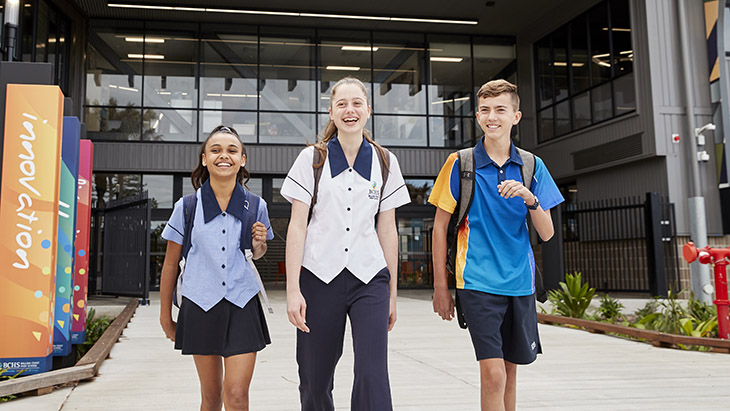Simple guide to supporting student social and emotional wellbeing
Supporting the social and emotional wellbeing of students at school provides a strong foundation for academic achievement as well as positive intrapersonal and interpersonal long-term outcomes. Social and emotional wellbeing encompasses a wide range of factors that should be considered including students':
- autonomy
- self-confidence and self-esteem
- attitudes towards themselves and others
- ability to connect and build relationships with familiar and unfamiliar peers and adults
- sense of belonging
- capacity to manage emotions in a variety of situations.

Key practices that schools can implement to support wellbeing
There are many factors that can have a positive (or protective) influence and creating learning environments that build community and promote feelings of safety and belonging is key.
Programs that promote student wellbeing within Australian schools are best implemented using an approach that is systemic, sustainable, targets the whole community, builds teacher capacity through training first, group-based, age-appropriate, and delivered regularly.
For more information, read the Student Health and Wellbeing Systematic Review.
Five practices that support student wellbeing are:

1. Promote a sense of belonging
Learning environments that use strengths-based inclusive practices, such as those found in our Inclusive Practice Hub, create environments where all students feel valued and supported by staff and peers. Students are then more likely to build on this feeling of belonging by connecting further with their school community. They are also more likely to experience increased feelings of competence, engagement, and intrinsic motivation to learn, pursue their interests, and thrive.
It is particularly relevant to:
- use strengths- and evidence-based strategies to facilitate inclusion
- hold high standards and set attainable goals
- focus on mastering new skills and provide challenging and meaningful work
- support student autonomy and voice
- have zero tolerance towards bullying, exclusion, and discrimination
- promote a culture that values and celebrates diversity
- provide many opportunities for positive peer interactions and school staff.

2. Creating a safe and predictable environment
Strategies such as providing clear structure and routines, and access to safe spaces, are particularly important for students who experience mental health challenges, or who have experienced trauma or adverse childhood experiences. Organised and predictable learning environments foster student autonomy and competence.
Furthermore, predictable routines reduce the number of stresses a student experiences and provides them with more mental and emotional space to manage emotions or stress. Some relevant approaches include creating a predictable daily or class routine, and using a consistent, fair, and positive approach to managing behaviours of concern.
3. Promoting family-school partnership
Family engagement with schooling is linked to student self-esteem, sense of school belonging, adjustment, academic achievement, and wellbeing. Family-school partnerships can also play an important role in providing consistent supports across home and school.
Ongoing communication between schools and families (and relevant professionals or other community members connected to a student) can help build a shared understanding of a student's strengths, abilities, and wellbeing. Meaningful partnerships can help provide consistency and stability for a student, while identifying areas of risk or need for further supports or intervention.

4. Developing secure, respectful, and reciprocal relationships
Secure, respectful, and reciprocal relationships lead to students’ increased engagement in learning, prosocial behaviour, feelings of safety at school, and reduced depression, anxiety and stress.
Some of the ways teachers and school staff can develop these relationships include using warm and open communication, taking a genuine interest in students, building trust through consistency and fairness, providing appropriate emotional support, recognising potential in all students, focusing on building student capacity for autonomy and discovery.

5. Teaching social-emotional skills
Teachers play an important role in helping students to acquire social and emotional skills. Some approaches that may be relevant include:
- modelling positive coping and emotion regulation strategies in the classroom
- actively teaching and prompting students to recognise and manage emotions and to resolve conflict
- providing students with regular opportunities to be physically active
- regularly practicing relaxation breathing techniques or mindfulness
- talking with students about healthy habits that support wellbeing and mental health, and positive coping strategies
- helping to identify the strategies that help them manage stress, and providing opportunity for them to use these.
Disruptive factors to consider
Exclusion
When students feel they are not accepted as they are, or are not included in a peer group, it can impact their wellbeing. All forms of exclusion can be harmful, including barriers to full participation and involvement in activities.
Some forms of exclusion, such as bullying and intentional social exclusion, can be particularly harmful. Exclusion and bullying can result in poorer academic performance, high levels of distress, low self-esteem, social challenges, difficulties sleeping, challenges with transitions (such as to a new school or learning environment), mental health challenges, and a higher risk of suicide.
Some students who are more likely to experience barriers to their inclusion, including being at risk for bullying, are: LGBTQIA students, students with disability, and students who have experienced race-based discrimination (direct or indirect), including Aboriginal and Torres Strait Islander students.
Academic success and expectations
Adverse childhood experiences and trauma
Adverse childhood experiences increase stress, which can change brain development. This may disrupt behaviours such as attention, learning, decision making and how a student manages stress or their emotions.
Some students who have experienced adverse childhood experiences may also experience difficulty forming healthy relationships and may be at a higher risk of depression and suicide.
School Excellence Framework alignment
Wellbeing, Effective classroom practice
Australian Professional Standards for Teachers alignment
Standard 1: Know students and how they learn
Audience
School leaders and secondary teachers
Purpose
This simple guide to supporting student’s social and emotional wellbeing considers a range of factors in establishing a school community where students belong.
Reviewed
November 2021. Share your feedback here